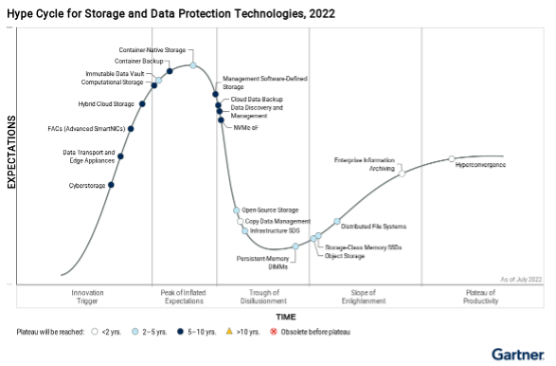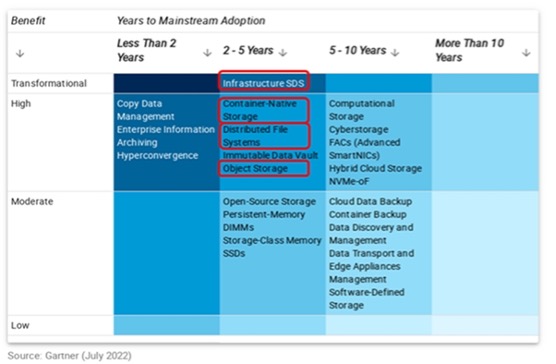In its latest Gartner report, the Hype Cycle for Storage and Data Protection Technologies (2022), Gartner describes the 21 most high-profile innovations in storage and data protection and defines and analyzes the value, adoption, and expected future growth rate of each technology for the enterprise. Software-defined storage infrastructure became the only transformative technology of the year, with distributed file systems, object storage, and container native storage all rated "high."

Distributed replaces vertical NAS to carry critical services
According to the 2022Gartner storage technology maturity curve, building a scalable and low-cost distributed storage platform for unstructured file data is a top priority for I&O leaders. The accelerated growth of existing unstructured data and the introduction of file-based workloads have brought distributed scale-out storage architectures to the forefront of IT infrastructure planning.
Gartner believes that distributed storage has three major opportunities. First, in the face of exponential growth in unstructured data, I&O leaders are increasingly replacing scale-up NAS device systems with distributed scale-out file system products to reap the benefits of linear scaling of capacity and performance. Second, enterprises are preparing for the exponential growth of unstructured data and seeking better data insights and integration with cloud storage for long-term data lifecycle management. Third, big data analytics, artificial intelligence (AI), and machine learning (ML) applications have become typical use cases for distributed storage.
For example, large-scale events will use 8K ultra-high definition for live broadcasting, and every frame of the video screen is very beautiful, and higher requirements are put forward for storage around the whole process of video acquisition, editing, broadcasting and management. Among them, the non-line editing process requires storage to provide high throughput and low latency to ensure video quality quality; The high value of video material requires the stable operation of the video processing process for 7 *24 hours.
For another example, autonomous driving has been very popular in recent years, and its training process includes data import, cleaning, pre-processing, training and simulation analysis, and different protocols are used in each link, and data circulation and copying will significantly reduce the efficiency of AI training and increase the amount of data storage; The training process requires large throughput and low latency to meet the needs of GPU training.
Finally, the virtualization/cloudification market has grown rapidly in recent years, more and more core key applications are on the cloud, and higher IOPS and lower latency are required in the data access process to ensure that key business operations are not stuck; The cloud platform business is growing rapidly, and it is necessary for the system to provide elastic space and the expansion of the system is more convenient.
Technically, we see that the report describes four main technologies located in the Plateau of Productivity, Trough of Disillusionment, and Peak of Inflated Expectations: hyperconvergence, infrastructure SDS, NVMe-oF, and container-native storage.
Summary
According to gartner Hype Cycle, several storage technologies based on distributed architectures and cloud-based infrastructure have reached or are nearing production maturity in the next 5 years or so. With the penetration of technology and the expansion of the market, whether manufacturers really have independently developed technology, production-ready products, stable and reliable solutions, flexible and convenient delivery forms, and fast response services will be the focus of enterprises to select storage solutions.
The digital economy has become a new engine of socio-economic development, and its prosperity and development will inevitably lead to explosive growth in data. IDC predicts that by 2025, China's data volume will grow to 48.6 ZB, 80% of which is unstructured data, and will become the world's largest data circle, which makes distributed storage that is good at storing and processing unstructured data a positive. At the same time, a series of policies such as data elements, eastern and western computing, and software development planning have been introduced, and various industries are encouraging the application and deployment of distributed related technologies, which is expected to promote the popularization and application of distributed storage at the infrastructure layer.
